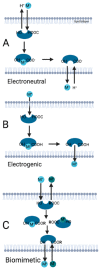Ionophore Toxicity in Animals: A Review of Clinical and Molecular Aspects
- PMID: 36675211
- PMCID: PMC9863538
- DOI: 10.3390/ijms24021696
Ionophore Toxicity in Animals: A Review of Clinical and Molecular Aspects
Abstract
For many years, ionophores have been used to control coccidiosis in poultry. However, misuse of ionophores can cause toxicity with significant clinical symptoms. The most critical factors influencing ionophores' toxicity are administration dose, species, and animal age. Although clinical signs of ionophore intoxication are well studied, the toxicity mechanisms of the ionophores at the molecular level still are not fully elucidated. This review summarizes the studies focused on polyether ionophores toxicity mechanisms in animals at the clinical and molecular levels. Studies show that ionophore toxicity mainly affects myocardial and skeletal muscle cells. The molecular mechanism of the toxication could be explained by the inhibition of oxidative phosphorylation via dysregulation of ion concentration. Tiamulin-ionophore interaction and the synergetic effect of tiamulin in ionophore biotransformation are discussed. Furthermore, in recent years ionophores were candidates for reprofiling as antibacterial and anti-cancer drugs. Identifying ionophores' toxicity mechanisms at the cellular level will likely help develop novel therapies in veterinary and human medicine.
Keywords: ionophore toxicity; ionophores; poultry.
Conflict of interest statement
The authors declare no conflict of interest.
Figures

Similar articles
-
Transformation of ionophore antimicrobials in poultry litter during pilot-scale composting.Environ Pollut. 2016 May;212:392-400. doi: 10.1016/j.envpol.2016.01.066. Epub 2016 Feb 11. Environ Pollut. 2016. PMID: 26874321
-
CP-72,588, a semisynthetic analog of the polyether ionophore UK-58,582 with increased anticoccidial potency.Antimicrob Agents Chemother. 1992 Oct;36(10):2080-4. doi: 10.1128/AAC.36.10.2080. Antimicrob Agents Chemother. 1992. PMID: 1444288 Free PMC article.
-
Quantification of ionophores in aged poultry litter using liquid chromatography tandem mass spectrometry.J Environ Sci Health B. 2012;47(10):959-66. doi: 10.1080/03601234.2012.706564. J Environ Sci Health B. 2012. PMID: 22938580
-
An analysis of the chronic oral toxicity of polyether ionophore antibiotics in animals.Vet Hum Toxicol. 1999 Aug;41(4):251-7. Vet Hum Toxicol. 1999. PMID: 10434384 Review.
-
Anti-parasitic activity of polyether ionophores.Eur J Med Chem. 2019 Mar 15;166:32-47. doi: 10.1016/j.ejmech.2019.01.035. Epub 2019 Jan 17. Eur J Med Chem. 2019. PMID: 30684869 Review.
Cited by
-
Comparative transcriptomics of salinomycin molecular toxicity in chicken and turkey.Sci Rep. 2025 Jul 1;15(1):21586. doi: 10.1038/s41598-025-08812-7. Sci Rep. 2025. PMID: 40596362 Free PMC article.
-
Accidental monensin poisoning in buffaloes in Minas Gerais, Brazil.Vet Res Commun. 2025 Jul 8;49(5):250. doi: 10.1007/s11259-025-10813-w. Vet Res Commun. 2025. PMID: 40627065
-
Insights into the Versatility of Using Atomic Absorption Spectrometry in Antibacterial Research.Molecules. 2024 Jun 30;29(13):3120. doi: 10.3390/molecules29133120. Molecules. 2024. PMID: 38999072 Free PMC article.
-
Potassium/sodium cation carriers robustly upregulate CD20 antigen by targeting MYC, and synergize with anti- CD20 immunotherapies to eliminate malignant B cells.Haematologica. 2025 Jul 1;110(7):1555-1572. doi: 10.3324/haematol.2024.285826. Epub 2024 Dec 19. Haematologica. 2025. PMID: 39704178 Free PMC article.
-
Assessment of Salinomycin's Potential to Treat Microcotyle sebastis in Korean Rockfish (Sebastes schlegelii).Animals (Basel). 2023 Oct 17;13(20):3233. doi: 10.3390/ani13203233. Animals (Basel). 2023. PMID: 37893959 Free PMC article.
References
-
- Dorne J.L.C.M., Fernández-Cruz M.L., Bertelsen U., Renshaw D.W., Peltonen K., Anadon A., Feil A., Sanders P., Wester P., Fink-Gremmels J. Risk Assessment of Coccidostatics during Feed Cross-Contamination: Animal and Human Health Aspects. Toxicol. Appl. Pharmacol. 2013;270:196–208. doi: 10.1016/j.taap.2010.12.014. - DOI - PubMed
-
- Novilla M.N. Veterinary Toxicology: Basic and Clinical Principles. 3rd ed. Academic Press; Cambridge, MA, USA: 2018. Ionophores; pp. 1073–1092.
Publication types
MeSH terms
Substances
Grants and funding
LinkOut - more resources
Full Text Sources
Medical

